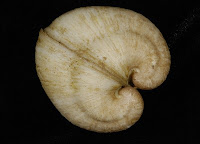Yesterday I was talking to the NIWA biologists about some of their discoveries from this expedition to the Kermadec undersea volcanoes.
In this first photo, Malcolm Clark is having a last look at the sled net to check that all sea creatures have been collected from it before it is sent down to the bottom again to take more samples.
Rob Stewart has created an impressive series of photographs of the animals found so far. He has a top quality studio set up in the biology lab on board and takes exquisite shots of the specimens.
(Thanks to Kareen Schnabel, NIWA for these first two photos.)
 Here is a small gallery of some of Rob’s pictures, chosen from his amazing collection. All of them courtesy of NIWA:
Here is a small gallery of some of Rob’s pictures, chosen from his amazing collection. All of them courtesy of NIWA:
This little lobster like crustacean was unknown until about 20 years ago. It is about 8 cm long.
This is a crinoid or sea lily. Related forms are found in the fossil record from long ago. They are related to starfish and fan out their feather like branches to catch food floating by in the water. This one can actually move along the sea bed using its leg- like lower branches. Its length is about 20cm.
This bivalve mollusc from Rumble 2 West Volcano has never been seen before by the NIWA biologists. It may be new to science. It is about 4 cm across.
 This fish is known as a rat tail. It scavenges about the sea floor in the murky depths seeking scraps to eat. This specimen is about 30 cm in length. It belongs to a large family of related species that are found between 30 to over 3000 metres of water depth.
This fish is known as a rat tail. It scavenges about the sea floor in the murky depths seeking scraps to eat. This specimen is about 30 cm in length. It belongs to a large family of related species that are found between 30 to over 3000 metres of water depth.

This sponge is a filter feeder. It is made of glass (silica), and those spines are sharp! Its overall length is 30 cm.
 This is a branching gorgonian coral from Clark Volcano. Unlike corals that live near the surface of the sea, deep sea corals do not have photosynthesising algae associated with them. They have to take all their food from the water that flows over them, using their tiny polyps. Brittle stars are very often found entwined in the coral branches.
This is a branching gorgonian coral from Clark Volcano. Unlike corals that live near the surface of the sea, deep sea corals do not have photosynthesising algae associated with them. They have to take all their food from the water that flows over them, using their tiny polyps. Brittle stars are very often found entwined in the coral branches.
 Here is a segmented worm or polychaete. It is carnivorous and also lives in the branching coral. Total length of this specimen is about 8 cm.
Here is a segmented worm or polychaete. It is carnivorous and also lives in the branching coral. Total length of this specimen is about 8 cm.

This brittle star uses its sucker like tube feet to move around in the branches of coral and also to catch food and carry it into its mouth in the central disc. This image is about 3 cm across.


Hi Julian, it seems from your pictures and articles, that you are having great time on the ocean. I think I can understand that, a well equiped ship with high tech equipment in a volcano hunt… Any sea sickness so far? Zoltan
thanks julian for such great content lease keep it up , I saw this documentary too it's amazing about Amazing sea creatures
https://www.youtube.com/watch?v=umKTHyJJrTk